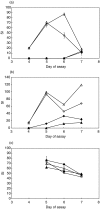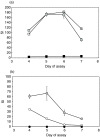Reactivity of T cells from women with antibodies to the human platelet antigen (HPA)-1a to peptides encompassing the HPA-1 polymorphism
- PMID: 16178861
- PMCID: PMC1809477
- DOI: 10.1111/j.1365-2249.2005.02903.x
Reactivity of T cells from women with antibodies to the human platelet antigen (HPA)-1a to peptides encompassing the HPA-1 polymorphism
Abstract
The human platelet antigen-1a (HPA-1a) is the most common alloantigenic target in fetal and neonatal alloimmune thrombocytopenia (NAIT). Treatment currently depends on the outcome in previous pregnancies. HPA-1 specific T cell responses were determined in 14 HPA-1a alloimmunized women during or after pregnancies affected by NAIT. Peripheral blood mononuclear cells were incubated with peptides encompassing the Leu33Pro polymorphism (residues 20-39 and 24-45 in both Leu33 (HPA-1a) and Pro33 (HPA-1b) forms) or control recall antigens in the presence of autologous sera and T cell proliferation was measured by (3)H-thymidine incorporation. Control antenatal and postpartum sera suppressed T cell proliferation and use of such sera was avoided. Most patients (86%) responded to the HPA-1a peptides with 64% also having weaker T cell proliferation to the HPA-1b peptides; 14% had no activity towards any peptide despite responding to control antigens. Administration of IVIG during pregnancy appeared to reduce T cell reactivity to HPA-1 peptides. Postnatal anti-HPA-1a T cell responses from women who had a severe history of NAIT (an intracranial haemorrhage in a previous fetus) were greater than those from women with a mild history. This assay may have the potential to predict disease severity if performed prior to or early in pregnancy.
Figures



Similar articles
-
Human platelet antigen (HPA)-1a peptides do not reliably suppress anti-HPA-1a responses using a humanized severe combined immunodeficiency (SCID) mouse model.Clin Exp Immunol. 2014 Apr;176(1):23-36. doi: 10.1111/cei.12242. Clin Exp Immunol. 2014. PMID: 24261689 Free PMC article.
-
Characterization of the alloreactive helper T-cell response to the platelet membrane glycoprotein IIIa (integrin-beta3) in human platelet antigen-1a alloimmunized human platelet antigen-1b1b women.Transfusion. 2005 Jul;45(7):1165-77. doi: 10.1111/j.1537-2995.2005.00188.x. Transfusion. 2005. PMID: 15987363
-
What's happening? The expanding role of apheresis platelet support in neonatal alloimmune thrombocytopenia: current status and future trends.Transfus Apher Sci. 2005 Oct;33(2):191-7. doi: 10.1016/j.transci.2005.06.001. Transfus Apher Sci. 2005. PMID: 16140039
-
The management of alloimmune neonatal thrombocytopenia.Baillieres Best Pract Res Clin Haematol. 2000 Sep;13(3):365-90. doi: 10.1053/beha.2000.0083. Baillieres Best Pract Res Clin Haematol. 2000. PMID: 11030040 Review.
-
Maternal HPA-1a antibody level and its role in predicting the severity of Fetal/Neonatal Alloimmune Thrombocytopenia: a systematic review.Vox Sang. 2019 Jan;114(1):79-94. doi: 10.1111/vox.12725. Epub 2018 Nov 22. Vox Sang. 2019. PMID: 30565711
Cited by
-
Human platelet antigen (HPA)-1a peptides do not reliably suppress anti-HPA-1a responses using a humanized severe combined immunodeficiency (SCID) mouse model.Clin Exp Immunol. 2014 Apr;176(1):23-36. doi: 10.1111/cei.12242. Clin Exp Immunol. 2014. PMID: 24261689 Free PMC article.
-
T cell responses to human platelet antigen-1a involve a unique form of indirect allorecognition.JCI Insight. 2016 Sep 8;1(14):e86558. doi: 10.1172/jci.insight.86558. JCI Insight. 2016. PMID: 27699233 Free PMC article.
-
Fetal/Neonatal Alloimmune Thrombocytopenia: Pathogenesis, Diagnostics and Prevention.Arch Immunol Ther Exp (Warsz). 2016 Aug;64(4):279-90. doi: 10.1007/s00005-015-0371-9. Epub 2015 Nov 12. Arch Immunol Ther Exp (Warsz). 2016. PMID: 26564154 Free PMC article. Review.
-
Antigen-specific immunotherapy for platelet alloimmune disorders.Hum Immunol. 2024 Nov;85(6):111172. doi: 10.1016/j.humimm.2024.111172. Epub 2024 Nov 8. Hum Immunol. 2024. PMID: 39520801 Review.
References
-
- Ginsberg MH, Loftus J, Ryckwaert JJ, Pierschbacher M, Pytela R, Ruoslahti E, Plow EF. Immunochemical and amino-terminal sequence comparison of two cytoadhesins indicates they contain similar or identical beta subunits and distinct alpha subunits. J Biol Chem. 1987;262:5437–40. - PubMed
-
- Fitzgerald LA, Poncz M, Steiner B, Rall SC, Jr, Bennett JS, Phillips DR. Comparison of cDNA-derived protein sequences of the human fibronectin and vitronectin receptor alpha-subunits and platelet glycoprotein IIb. Biochemistry. 1987;26:8158–65. - PubMed
-
- Williamson LM, Hackett G, Rennie J, et al. The natural history of fetomaternal alloimmunization to the platelet-specific antigen HPA-1a (PlA1, Zwa) as determined by antenatal screening. Blood. 1998;92:2280–7. - PubMed
-
- Decary F, L'Abbe D, Tremblay L, Chartrand P. The immune response to the HPA-1a antigen: association with HLA-DRw52a. Transfusion Med. 1991;1:55–62. - PubMed
Publication types
MeSH terms
Substances
LinkOut - more resources
Full Text Sources

